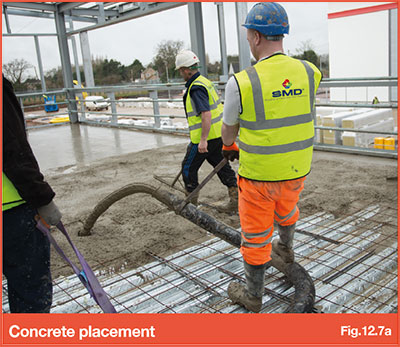12.8 - Placement
As detailed in section 6.3.1 of SCI P300 – Composite Slabs & Beams Using Steel Decking: Best Practice for Design & Construction, concrete on metal deck should be placed to achieve a constant thickness rather than a defined datum level to:
- • Eliminate the risk of overloading the deck and possible collapse
- • Avoid additional cost for over consumption of concrete
- • Ensure design slab thickness is maintained for pre-cambered beams
Where the concrete contractor proposes to pour the concrete to a defined datum (i.e. using a laser level), this must be checked with the project structural engineer and metal deck manufacturer to assess whether the additional concrete weight for ponding (as a result of deflection of the steel frame) has been considered in design.

Refer 4.1 Construction stage and construction deflections Section 4.1.2 - Effect of Construction Stage Deflection on Surface Level and Flatness Tolerances.
The recommended means of pouring concrete onto metal deck is by pumping. Where the concrete is transferred into position using barrows or by lines of pipe for pumping, boards should be used to provide a load-spreading platform across the deck, thus reducing the risk of accidental damage to the profile.
The wet concrete must not be heaped, or dropped from a height exceeding 1.0m in any area during the laying sequence. When poured in the same direction as the decking span, concrete should be poured evenly over two spans starting at beam positions.
When concrete is poured in a direction at right angles to the span it should be placed first at the edge where a decking sheet is supported by the underlap of an adjacent sheet. This helps to ensure that the longitudinal side laps between sheets remain closed and hence minimises grout loss. The concrete should be well compacted using either a vibrating beam or plate vibrator, particularly locally around shear studs. Needle head vibrating pokers are not recommended as these can result in greater grout loss.
Refer to SCI AD 344: Levelling techniques for composite floors for more information
Refer to Section '11.8 - Minimising grout loss for more information.
Go to NEXT section

